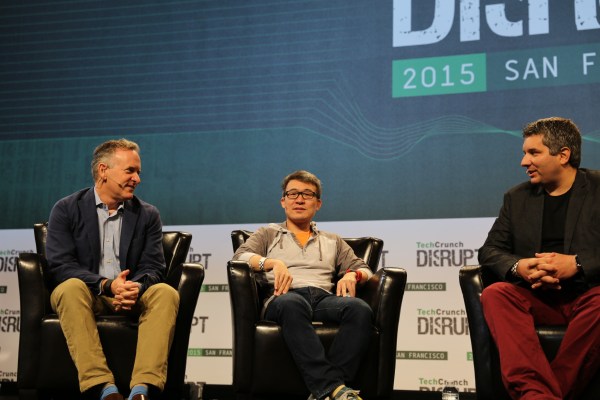If you’ve ever glanced at your wrist and wondered why so many tech companies are vying for such a relatively small strip of flesh, chances are you’re not thinking big enough. And you’re definitely not thinking like a VC.
“Wearables is one of these — like the Internet, like cloud, like robotics — very, very large horizontal markets. It literally encompasses huge segments of the population for huge functionalities,” said True Ventures’ Jon Callaghan, during an on stage interview here at TC Disrupt SF. “We don’t really see that very often in venture capital, so I think this is one of the most exciting categories and frankly computing platforms that’s out there right now.”
“The Fitbit vision and frankly the mission is much broader than any one specific device being pitted against another. It truly is to enable people to lead healthier lifestyles,” added Callaghan.
He was speaking during a fireside chat with TC’s John Biggs and Fitbit CEO and co-founder James Park. True Ventures was an early Fitbit investor, participating in Fitbit’s first external funding round back in 2008 — and cashing out handsomely this June when the company went public.
Have a mission, really, really believe and do something very, very challenging.
Fitbit’s journey is the stuff that entrepreneur dreams are made on. From its software-focused founders’ original decision to step off piste to build hardware after being inspired by the Nintendo Wii — “we didn’t know anything about hardware at the time… in hindsight it was probably something completely dumb for us to do,” said Park — to pitching their first prototype at TC 50 back in 2008, when they demoed a circuit board stuck inside a glued together DIY balsa wood case. To the big one: this year’s IPO, which pulled some $358 million into the company’s coffers.
These days, of course, the tech space is lousy with all sorts of wearables. And very large players like Apple have their own hyper-polished bets. But Fitbit’s Park is not concerned about all this competition — even that oh-so-shiny wristwear being designed in Cupertino.
“I think observers and press actually like to view almost every market as some kind of life and death battle — winner takes all. But the health and fitness category is a pretty large and diverse opportunity,” he argued. “Consumers spend over $200 billion on health and fitness products and services. So there’s going to be a lot of different companies that win in different bits of this market.
“For us and Apple, we don’t see ourselves as directly competitive today. And the numbers show it. Year over year our revenue tripled towards $400 million last quarter. The guidance that we gave analysts for our last earnings call was $1.7 billion in revenue this year, so we’re doing incredibly well. And I think consumers like the fact that we’re really focused on the category.”
One specific characteristic of the U.S. market that’s helping driving coins towards Fitbit’s coffers is high health insurance costs. “It was a big win for us,” noted Park, referring to a recent deal with retailer Target which will offer Fitbits to its 335,000 employees. “Corporate wellness is a big thing. In the U.S. in particular health insurance costs is a big thing. Companies are looking for any way — piece of technology — to help their employees get healthier.”
In terms of the specifics of Fitbit standing out in a sweaty crowd, Park emphasized the variety in its product portfolio as one part of its strategy, along with a focus on core consumer issues like battery life. “People trust our products,” he said. “We have a broad range of products at different price-points, different styles, cross platform compatibility, we have a lot of focus on battery life which also matters in this category. So there’s a lot of different ways we try to cater to consumer needs.”
“I think what people overlook too is the power of the software and the social network that’s behind Fitbit,” added Callaghan, discussing the importance of branding and ecosystem in the fitness category. “Fitbit’s probably one of the largest fitness-focused social networks in the world. In fitness I’ve been an investor in the fitness category for a very long time — it’s very, very challenging to have a brand that is both high performance for athletes in the performance activity and also really approachable to everyone.”
“Fitbit’s done a remarkable job opening up this category to this enormous chunk of the market. Both at the high end but also with different form factors and price points. Not many companies in history have done that. Nike is one example. So it’s very challenging to do that in this category. I think it’s a great testament to their brand and their vision,” he added.
So what should budding hardware entrepreneurs be thinking as they dream about building the next Fitbit? “Have a mission, really, really believe and do something very, very challenging,” said Callaghan. “I always say hardware is the double black diamond of startups. It’s not the easy path. It’s not for the faint of heart. Doing something round the edge of a category, not interesting at all. Reinvent a category. Think about 10 and 20 years, as hard as that is. That’s what gets us excited.”
